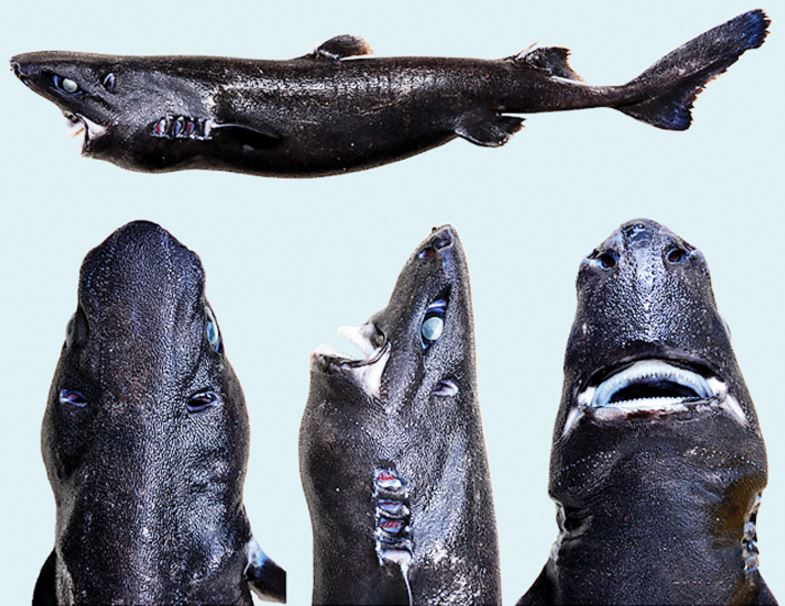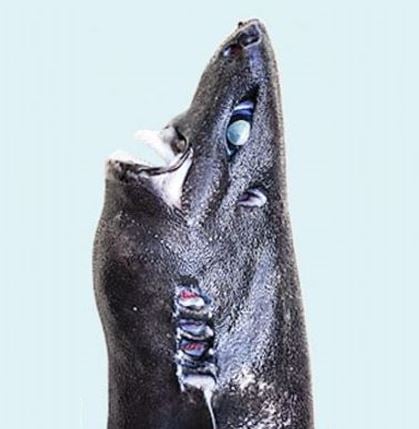The newly discovered Ninja Lanternshark that glows in the dark, has bulbous eyes and jet-black skin, is officially called Etmopterus benchleyi, after Peter Benchley (1940-2006), the American author best known for his novel Jaws and its subsequent film adaptation directed by Steven Spielberg.
Researcher Vicky Vásquez, a graduate student at the Pacific Shark Research Center, Part of Moss Landing Marine Laboratories in California, said the name Ninja Lanternshark was the result of a conversation she had with her 8-year-old cousins.
Ms. Vásquez told the children that this species of shark uses photophores (light-emitting organs) in its skin, making it glow slightly in the deep and dark ocean.
 Ninja lanternshark, known scientifically as Etmopterus benchleyi. (Image: Wikipedia. Credit: Vásquez, V.E., Ebert, D.A. & Long, D.J.)
Ninja lanternshark, known scientifically as Etmopterus benchleyi. (Image: Wikipedia. Credit: Vásquez, V.E., Ebert, D.A. & Long, D.J.)
Glowing feature is likely a survival trait
Shark biologists believe Etmopterus benchleyi, which can reach about half-a-metre in length, uses this cloaking ability to blend in with the little light there is in that part of the ocean, so that for creatures below looking up, it appears invisible.
Marine creatures sneak up on prey – such as smaller fish and shrimp – from below. The glowing effect also makes the shark appear larger than it really is, which probably puts off some predators.
According to Hakai Magazine, part of the Tula Foundation and Hakai Institute family, the animal’s intriguing stealth, plus its sleek, black appearance led Ms. Vásquez’s young cousins to suggest naming it the Super Ninja Shark.
Wondering whether her colleagues would go for such a long name, she suggested the kids scale it back a bit.
An exciting name gets people interested
Ms. Vásquez said:
“We don’t know a lot about lanternsharks. They don’t get much recognition compared to a great white. So when it came to this shark I wanted to give it an interesting story.”
Dr. David A. Ebert, Program Director at the Pacific Shark Research Centre, said:
“Taxonomy can sometimes be kind of dry, but the naming thing always gets people excited.”
Dr. Ebert says the latest discovery of the Ninja Lanternshark just goes to show how many species are still out there in our oceans waiting to be described.
 Victoria Elena Vásquez (Vicky) and Dr. David A. Ebert. (Images: psrc.mlml.calstate.edu)
Victoria Elena Vásquez (Vicky) and Dr. David A. Ebert. (Images: psrc.mlml.calstate.edu)
Dr. Ebert added:
“About 20 percent of all shark species have been discovered in just the last ten years. My whole research is looking for ‘lost sharks’.”
The Ninja Lanternshark, of the family Etmopteridae, is found in the eastern Pacific Ocean from Nicaragua, south to Panama and Costa Rica. According to what we know so far, it lives in a depth ranging from 836 to 1,443 metres along the continental slope.
It is the only Etmopterus species known to scientists that lives along the Pacific coast of Central America.
According to the eight specimens collected, males can reach a length of 235 millimetres (12.8 inches) and females 515 millimetres (20.3 inches).
Video – Ninja Lanternshark discovered off coast of Central America

